I’ve taken a several-month hiatus from blogging, but with good reason. In December, I welcomed this little guy to my family.
Look at those cheeks!
The fatigue of late pregnancy and the early newborn weeks – combined with a busy work schedule, my two older boys and husband, and a host of other “real-life” obligations – left me little time for blogging over the past several months. But I’m ready to re-enter the blogosphere. And, since I’m living with a newborn and will be teaching physical therapy students about infant development later this spring, it makes perfect sense to create a series of posts on newborn development. Today’s post is on primitive reflexes.
Primary standing & stepping
When most people think about reflexes, they think about sitting on the table in the doctor’s office getting hit on the knee with a rubber hammer. Those types of reflexes are called deep tendon reflexes and are completely different than the primitive reflexes I’m writing about today.
Primitive reflexes are a set of involuntary movements that are typically seen in the newborn infant. These reflexes originate in the lower, more primitive parts of the central nervous system (hence the name primitive reflexes). Parents are often surprised and sometimes even entertained when I show them primitive reflexes in their baby – because they are involuntary, they can be elicited in a newborn baby almost any time and are often times quite strong. But primitive reflexes are more than cool newborn party tricks (Look, Grandma! I’m 2 weeks old and I can stand!). They give healthcare providers important information about a baby’s neurological function.
Asymmetrical tonic neck reflex
When a baby is born, the higher centers of the central nervous system – areas that allow for voluntary movement – are not fully developed. This means that lower areas of the brain are in control and primitive reflexes dominate movement. In the first few months of life, the presence of primitive reflexes tells us that the lower portions of the central nervous system are functioning as they should. If primitive reflexes are absent or otherwise abnormal (weak or asymmetrical), we may suspect neurological injury or dysfunction in these lower areas of the central nervous system.
By 6-12 months of age, the higher, more sophisticated areas of the brain mature and voluntary movements dominate. In older babies, we expect primitive reflexes to integrate or “disappear” as more purposeful movements emerge. If we continue to see primitive reflexes in the older infant, we suspect that the higher centers of the brain may not be developing normally. Persistence of primitive reflexes can inhibit future development, making it difficult for the baby to learn to roll over, creep and crawl, reach and grasp, stand, and walk. Of course, primitive reflexes never really disappear – they continue to “live” in the lower brain and spinal cord and are simply masked by more mature brain function. This is why primitive reflexes may also be assessed in an older child or adult with neurological disease or injury – the reappearance of primitive reflexes may indicate damage to higher centers of the brain.
Plantar grasp
The following primitive reflexes are frequently tested by physicians, nurses, and physical and occupational therapists as part of a newborn neurological exam:
- Asymmetrical tonic neck reflex (also known as the “fencing” reflex) – When baby’s head is turned to the side, he assumes a “fencing” posture by extending one arm in front of his face and bending the other arm behind his head.
- Rooting/sucking – When the skin next to baby’s lips is stroked, she turns her head to find the stimulus and attempts to “latch” on and suck.
- Palmar and plantar grasp – Pressing into the palm of the hand or ball of the foot causes the baby to grasp with his fingers/toes.
- Primary standing and stepping – When held in a supported standing position, the newborn “stands” and even takes some steps.
- Galant reflex – Stroking along the side of the baby’s spine causes the spine to curve toward that side.
- Moro reflex – When the baby’s head is dropped backward, it elicits a “startle” (he quickly extends both arms), recovery (arms back to midline), and a cry.
For more information or to see primitive reflexes in action, check out the video:
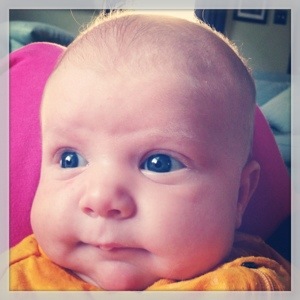
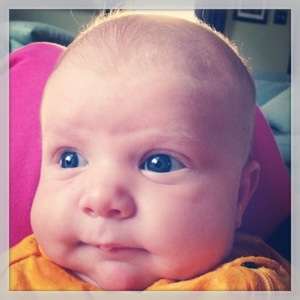
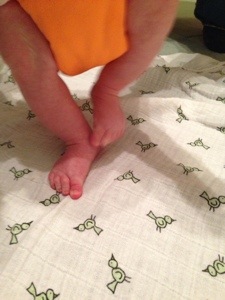
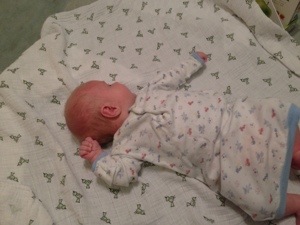
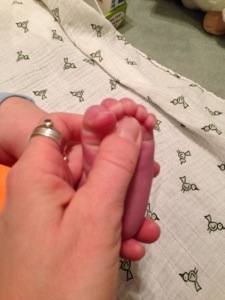
Dear Kendra,
I am an Assistant Professor at a medical school in Indiana.
I came across your website during a google search.Would you mind if I include one of your photos in a lecture that I will be giving to my students?I especially like the ‘Plantar grasp’ image above.
Please let me know your preference regarding reproduction of your work for educational purposes.
Sincerely,
Emily
Hi, Emily. You are welcome to use my videos for educational purposes as long as you credit me and link directly to them on YouTube or my blog site. Feel free to message me at kendragagnon [at] gmail [dot] com if needed.
Hi Kendra,
I am post-doctrate in Physics and we were blessed with a baby boy five months ago. He still shows ATNR relflex and rooting reflex (not so strong though). His stepping reflex inhibited few weeks back (I must write that he is a small, petite baby). My wife is pretty much worried about the fact that why his ATNR reflex is not integrated/inhibited by now. He can roll onto both sides, brings hands onto midline, grasps toys etc. Should we be worried? What can I explain to my wife to make her less worrisome.
Regards,
Jayakrishna
The ATNR integrates between 4-6 months, so it may be that your little guy just hasn’t integrated yet. From what you described, his other motor skills seem right on target. I would suggest that you talk to your pediatrician at your next well check about your concerns. He or she can look more closely to determine whether there are concerns and make a referral to a therapist or specialist if needed.
My baby is four weeks old. She doesn’t seem to have a Palmar reflex. Her hands are open most of the time. I try to get her to grasp me (when dressing her, for instance) and it is rare that she will close her hand. The nurse told me to mention it to the doctor at the 2-month checkup.Should I be concerned or try to stimulate the baby to promote her development in the meantime?
I love that kid……
that kid Is so cute like my friendat school
Hi Kenda,
This video is a fantastic demonstration! Thank you so much for sharing. May I ask Robert’s gestational age?
Thanks!
Brittany
Thanks! He was born via a planned c-section at 39 weeks gestation and is right at 1 month chronological age in the video.